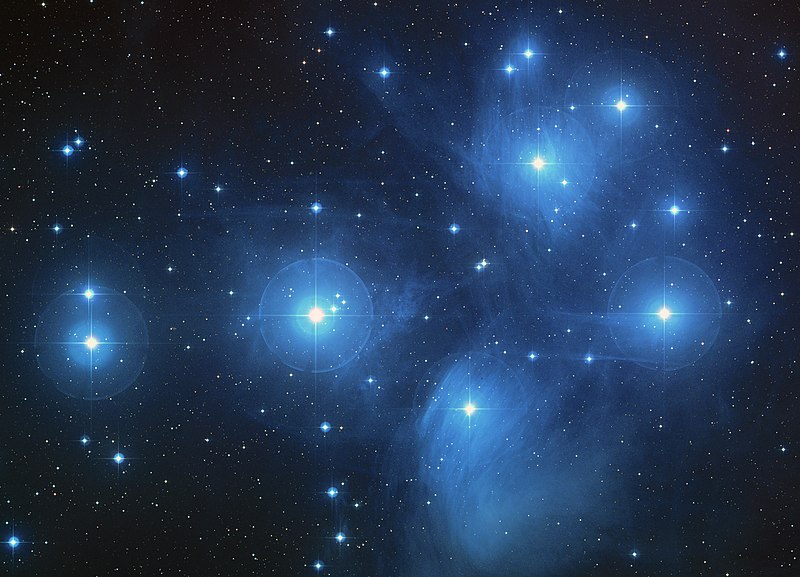THE SOUTHWORTH PLANETARIUM
70 Falmouth Street Portland, Maine 04103
(207) 780-4249 usm.maine.edu/planet
43.6667° N 70.2667° W
Altitude: 10 feet below sea level
Founded January 1970
2021-2022: CXLV
"The most remarkable discovery in all of astronomy is that the stars are made of atoms of the same kind as those on Earth."
-Richard Feynman
THE DAILY ASTRONOMER
Wednesday, July 6, 2022
July 2022 Night Sky Calendar Part III
SATURDAY, JULY 23: MOON NEAR THE PLEIADES

"Glitter like a swarm of fireflies tangled in a silver braid," or so wrote Alfred Lord Tennyson in reference to the enchantingly beautiful galactic star cluster poised on Taurus the Bull's shoulder. The image above, a color composite captured by the Digitized Sky Survey, reveals the nebulosity surrounding the stars. Dubbed the "Maia Nebula," after the name of one of the cluster's stars, this "cloud" was once thought to have been the remnant of the 120-million year old cluster's birth nebula. Astronomers know now that this nebula has no connection to the cluster's development. The stars are merely moving through this swath of gas and dust, which reflects the starlight, lending it a bluish-glow. Consequently, it is known as a "reflection nebula."
Tonight, the waning crescent moon (23% illuminated) appears to pass close to the Pleiades. See them both in the early morning eastern sky.
TUESDAY, JULY 26: MOON NEAR VENUS
Always a gorgeous sight! Find the waning crescent moon (4% illuminated) near Venus, the brightest planet. One will find both worlds in the eastern sky by 3 a.m.
THURSDAY, JULY 28: NEW MOON
Beginning of lunation cycle 123
PLANET WATCH
MERCURY: This mis-behaving miscreant of a planet whips around the Sun at speeds often exceeding 160,000 miles per hour. This lust for speed is a result of its close proximity to the Sun. Its year lasts as long as 88 Earth days and so it appears to vacillate between the western evening and eastern morning sky. Early this month, Mercury appears low in the eastern sky. By the second week of July, Mercury will vanish. After passing through superior solar conjunction on July 16th, Mercury will move into the western evening sky next month. VERDICT: Find Mercury in the pre-dawn sky sometime during the first ten days of July and then don't bother until August.
VENUS: Brilliant, as always, of course. Although Venus is never dim, it is close to its minimum brightness this month at magnitude -3.8. It still appears nine times brighter than Sirius, the night sky's brightest star. VERDICT: Find Venus in the early morning sky. Venus will vanish into the pre-dawn twilight early this autumn, so find it while you can.
MARS: The red planet rises around 1 a.m. at month's beginning and just before midnight toward the end of July. By the end of the month, Mars will be almost as bright as Rigel, the night sky's sixth brightest star. VERDICT: Mars is becoming a beautiful sight for night owls and early risers alike. Mars brightens throughout the rest of summer and autumn, so one will have ample opportunity to see the red planet.
JUPITER (PICK PLANET!): The behemoth planet rises after midnight at the beginning of July and after July at month's end. Shining at magnitude -2.3, Jupiter is more than twice as bright as Sirius. VERDICT: A perfect planet for late night viewers. Jupiter becomes even more prominent and rises earlier in August and September.
SATURN: The ringed planet leads the planetary parade in the early morning sky. See it rise after 10 p.m. Even though it will be at opposition next month, Saturn is still slightly dimmer than Mars. VERDICT: Go out to observe this moderately bright planet starting in the mid-evening! Be sure to seek it out next month when Earth passes between Saturn and the Sun.
To subscribe or unsubscribe from the Daily Astronomer: